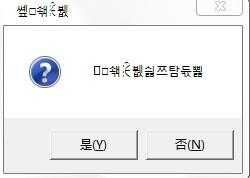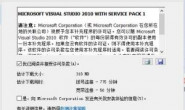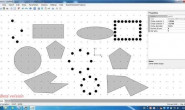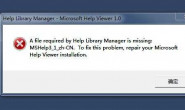代码:
#include<windows.h>
int main()
{
MessageBox(NULL,(LPCWSTR)”你想在全屏模式下运行么?”, (LPCWSTR)”设置全屏模式”,MB_YESNO|MB_ICONQUESTION);
return 0;
}
为什么生成的窗口出现乱码?

#include <windows.h>
#include <tchar.h>
int main()
{
MessageBox(NULL,_T("你想在全屏模式下运行么?"), _T("设置全屏模式"),MB_YESNO|MB_ICONQUESTION);
return 0;
}
假如还是不对,参考下面:
MessageBoxEx
The MessageBoxEx function creates, displays, and operates a message box. The message box contains an application-defined message and title, plus any combination of predefined icons and push buttons. The wLanguageId parameter specifies which set of language resources is used for the predefined push buttons. For full descriptions of the other parameters of MessageBoxEx, see MessageBox.
int MessageBoxEx(
HWND hWnd, // handle of owner window
LPCTSTR lpText, // address of text in message box
LPCTSTR lpCaption, // address of title of message box
UINT uType, // style of message box
WORD wLanguageId // language identifier
);
Parameters
hWnd
Identifies the owner window of the message box to be created. If this parameter is NULL, the message box has no owner window.
lpCaption
Pointer to a null-terminated string containing the message to be displayed.
lpszTitle
Pointer to a null-terminated string used for the dialog box title. If this parameter is NULL, the default title Error is used.
uType
Specifies a set of bit flags that determine the contents and behavior of the dialog box. This parameter can be a combination of flags from the following groups of flags.
Specify one of the following flags to indicate the buttons contained in the message box: Flag Meaning
MB_ABORTRETRYIGNORE The message box contains three push buttons: Abort, Retry, and Ignore.
MB_OK The message box contains one push button: OK. This is the default.
MB_OKCANCEL The message box contains two push buttons: OK and Cancel.
MB_RETRYCANCEL The message box contains two push buttons: Retry and Cancel.
MB_YESNO The message box contains two push buttons: Yes and No.
MB_YESNOCANCEL The message box contains three push buttons: Yes, No, and Cancel.
Specify one of the following flags to display an icon in the message box: Flag Meaning
MB_ICONEXCLAMATION,
MB_ICONWARNING
An exclamation-point icon appears in the message box.
MB_ICONINFORMATION, MB_ICONASTERISK
An icon consisting of a lowercase letter i in a circle appears in the message box.
MB_ICONQUESTION A question-mark icon appears in the message box.
MB_ICONSTOP,
MB_ICONERROR,
MB_ICONHAND
A stop-sign icon appears in the message box.
Specify one of the following flags to indicate the default button: Flag Meaning
MB_DEFBUTTON1 The first button is the default button.
MB_DEFBUTTON1 is the default unless MB_DEFBUTTON2, MB_DEFBUTTON3, or MB_DEFBUTTON4 is specified.
MB_DEFBUTTON2 The second button is the default button.
MB_DEFBUTTON3 The third button is the default button.
MB_DEFBUTTON4 The fourth button is the default button.
Specify one of the following flags to indicate the modality of the dialog box: Flag Meaning
MB_APPLMODAL The user must respond to the message box before continuing work in the window identified by the hWnd parameter. However, the user can move to the windows of other threads and work in those windows.
Depending on the hierarchy of windows in the application, the user may be able to move to other windows within the thread. All child windows of the parent of the message box are automatically disabled, but popup windows are not.
MB_APPLMODAL is the default if neither MB_SYSTEMMODAL nor MB_TASKMODAL is specified.
MB_SYSTEMMODAL Same as MB_APPLMODAL except that the message box has the WS_EX_TOPMOST style. Use system-modal message boxes to notify the user of serious, potentially damaging errors that require immediate attention (for example, running out of memory). This flag has no effect on the user””s ability to interact with windows other than those associated with hWnd.
MB_TASKMODAL Same as MB_APPLMODAL except that all the top-level windows belonging to the current thread are disabled if the hWnd parameter is NULL. Use this flag when the calling application or library does not have a window handle available but still needs to prevent input to other windows in the calling thread without suspending other threads.
In addition, you can specify the following flags:
MB_DEFAULT_DESKTOP_ONLY
The desktop currently receiving input must be a default desktop; otherwise, the function fails. A default desktop is one an application runs on after the user has logged on.
MB_HELP
Adds a Help button to the message box. Choosing the Help button or pressing F1 generates a Help event.
MB_RIGHT
The text is right-justified.
MB_RTLREADING
Displays message and caption text using right-to-left reading order on Hebrew and Arabic systems.
MB_SETFOREGROUND
The message box becomes the foreground window. Internally, the system calls the SetForegroundWindow function for the message box.
MB_TOPMOST
The message box is created with the WS_EX_TOPMOST window style.
MB_SERVICE_NOTIFICATION
Windows NT: The caller is a service notifying the user of an event. The function displays a message box on the current active desktop, even if there is no user logged on to the computer.
If this flag is set, the hWnd parameter must be NULL. This is so the message box can appear on a desktop other than the desktop corresponding to the hWnd.
For Windows NT version 4.0, the value of MB_SERVICE_NOTIFICATION has changed. See WINUSER.H for the old and new values. Windows NT 4.0 provides backward compatibility for pre-existing services by mapping the old value to the new value in the implementation of MessageBox and MessageBoxEx. This mapping is only done for executables that have a version number, as set by the linker, less than 4.0.
To build a service that uses MB_SERVICE_NOTIFICATION, and can run on both Windows NT 3.x and Windows NT 4.0, you have two choices. At link-time, specify a version number less than 4.0; or
2. At link-time, specify version 4.0. At run-time, use the GetVersionEx function to check the system version. Then when running on Windows NT 3.x, use MB_SERVICE_NOTIFICATION_NT3X; and on Windows NT 4.0, use MB_SERVICE_NOTIFICATION.
MB_SERVICE_NOTIFICATION_NT3X
Windows NT: This value corresponds to the value defined for MB_SERVICE_NOTIFICATION for Windows NT version 3.51.
wLanguageId
Specifies the language in which to display the text contained in the predefined push buttons. This value must be in the form returned by theMAKELANGID macro.
For a list of the language identifiers supported by Win32, seeLanguage Identifiers. Note that each localized release of Windows and Windows NT typically contains resources only for a limited set of languages. Thus, for example, the U.S. version offers LANG_ENGLISH, the French version offers LANG_FRENCH, the German version offers LANG_GERMAN, and the Japanese version offers LANG_JAPANESE. Each version offers LANG_NEUTRAL. This limits the set of values that can be used with the wLanguageId parameter. Before specifying a language identifier, you should enumerate the locales that are installed on a system.
Return Values
If the function succeeds, the return value is a nonzero menu-item value returned by the dialog box.
Value Meaning
IDABORT Abort button was selected.
IDCANCEL Cancel button was selected.
IDIGNORE Ignore button was selected.
IDNO No button was selected.
IDOK OK button was selected.
IDRETRY Retry button was selected.
IDYES Yes button was selected.
If a message box has a Cancel button, the function returns the IDCANCEL value when either the esc key or Cancel button is pressed. If the message box has no Cancel button, pressing the esc key has no effect.
If the function fails, the return value is zero. To get extended error information, callGetLastError.
Remarks
When you create a system-modal message box to indicate that the system is low on memory, the strings passed as the lpText and lpCaption parameters should not be taken from a resource file, because an attempt to load the resource may fail.
When an application calls the MessageBoxEx function and specifies the MB_ICONHAND and MB_SYSTEMMODAL flags for the uType parameter, the Win32 API displays the resulting message box regardless of available memory. When you specify these flags, the system limits the length of the message-box text to one line.
If you create a message box while a dialog box is present, use the handle of the dialog box as the hWnd parameter. The hWnd parameter should not identify a child window, such as a dialog box.
Windows 95: The system can support a maximum of 16,364 window handles.
QuickInfo
Windows NT: Requires version 3.1 or later.
Windows: Requires Windows 95 or later.
Windows CE: Unsupported.
Header: Declared in winuser.h.
Import Library: Use user32.lib.
Unicode: Implemented as Unicode and ANSI versions on Windows and Windows NT.
See Also
Dialog Boxes Overview, Dialog Box Functions,MAKELANGID,MessageBeep, MessageBox, MessageBoxIndirect, SetForegroundWindow




